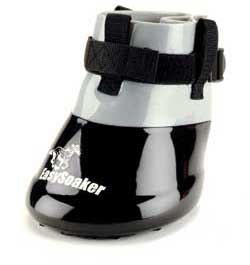Original article by Maria Siebrand of The Thoughtful Horseman.
Measuring Uniform, Adequate Sole Depth Using the Collateral Grooves

The above image is from Marjorie Smith’s barefoothorse.com (thank you, Marjorie!) but I’ve relabeled the image because there were a few landmarks unacknowledged or labeled by a different name than I generally use in the original, states Maria Siebrand, natural hoof trimming practitioner.
First and foremost, we need to distinguish between the COLLATERAL GROOVES, which run along either side of the frog, and the CENTRAL SULCUS, or the midline at the back of the frog, running forward from the heel bulbs.
The CENTRAL SULCUS is an important indicator of frog health. In a healthy hoof, the CENTRAL SULCUS should be no more than a dimple down the midline of the frog. In an unhealthy hoof, the central sulcus becomes a deep fissure, which can run deep into the heel bulbs. This contracted central sulcus is created by infection, as well as by mechanical heel contraction (can be caused by small shoes, eggbar shoes, etc.) A deep central sulcus, therefore, is a sign of an unhealthy hoof, and if your horse’s hoof has this problem, you’ll be instructed to start practicing a strict hoof hygiene protocol, including chlorine dioxide soaking and scrubbing with a stiff brush and dish detergent.
The COLLATERAL GROOVES, on the other hand, should NOT be expected to be shallow. The depth of the collateral grooves, measured at the apex of the frog and at the heels, give us the most accurate read on uniform adequate sole depth we can possibly expect without an X-ray. Shallow collateral groove depth indicates thin soles! A good standard for adequate collateral groove depth at the frog apex is about 5/8″, measured with your hoof pick at the side of the tip of the frog, to the edge of the sole plane adjacent to the lamina at either side. A good standard for adequate collateral groove depth at the heel is about 1″, measured with your hoof pick at the back of the frog, to the edge of the sole plane adjacent to the lamina in the heel triangle. The bottom line is the entire goal of a good trim: adequate uniform sole depth.
Keep in mind that not all horses will meet those standards. Those are the ideals, but trimming every hoof to those parameters immediately is usually not a good idea. Our goal is to ease the horse through the transition, towards the ideal, while keeping the horse as comfortable as possible without compromising hoof mechanism. A good trimmer will know when and how much to allow the collateral groove depth to vary.
It’s also important to understand that hoof shape varies from horse to horse, largely dictated by the shape of the horse’s coffin bone and lateral cartilages. The collateral grooves will look wider or narrower depending on the shape of the internal structures, but the depth of the grooves is still a consistent marker.
Pete Ramey describes the importance of the collateral grooves best:
“How do we know when we have adequate thickness, excess thickness, or not enough? Easy. Nature gave us a trustworthy guide in the collateral grooves. If we learn to read them, we will never have to wonder what needs to be done or not done to the bottom of the foot. The very special thing about the collateral grooves is that they are very consistent in their depth to the underlying inner structures. If you cut the grooves deeper on a cadaver hoof, you’ll find that it is about ½ inch to the sensitive corium; whether the rest of the sole is too thick or too thin. This means that if a horse has too much sole, the collateral grooves will be too deep. If there is not enough sole thickness the collateral grooves will be too shallow. Only a sub-solar abscess can push the grooves farther from the coffin bone, and I have never seen or heard of a situation that brings them too close.
All we have to do is understand how deep the grooves are naturally, and we will immediately be able to tell if the inner structures are too close to the outdoors or too far away. This applies to the front of the foot and to the back. We can’t put exact dimensions to this, because different coffin bones have different amounts of solar concavity, and of course it varies by hoof size. A little bit too much sole bothers horses far less than having too little, so I tend to begin by erring on the side of caution. Wild hooves and healthy domestic hooves with uniform sole thickness tend to have their collateral grooves (at the deepest part) about ¾” off the ground at the apex of the frog, and about an inch off the ground toward the back (Near the termination of the bars). These measurements can be taken by laying a rasp across the foot and measuring down to the bottom of the groove.”
Read Pete’s article in its entirety here:
http://www.hoofrehab.com/horses_sole.htm
Protective horse boots can help in your quest to provide natural horse care for your horses’ hoof care needs. Easyboot Soaker boots for instance can help with soaking needs to make the frogs and heel bulbs look their best and treat any bacterial issues that may be happening.

Easyboot Soaker
Nancy Fredrick

EasyCare Office Manager
As the office manager, I make sure the general operations of the organization run smoothly and seamlessly from A to Z. I have been on the EasyCare team since 2001 and have first hand product knowledge as my horses are barefoot and booted.




